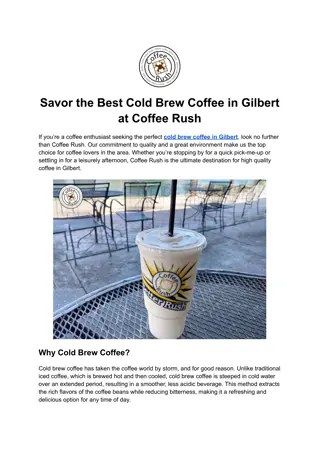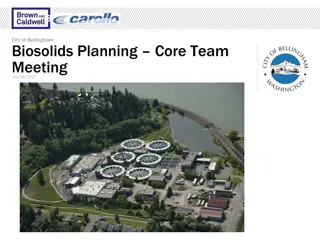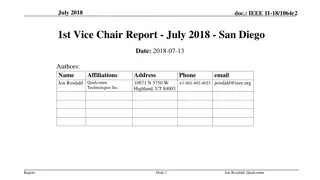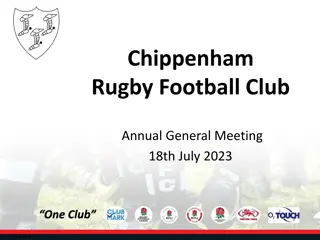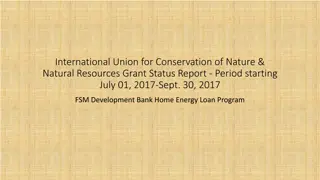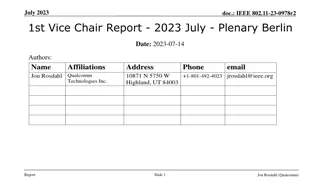Brew Club Meeting Highlights - July 2017
The July 2017 brew club meeting featured discussions on new members, recent competition results, upcoming activities like Beehive Brewoff and the Annual Summer Picnic, ongoing events such as the Hoppy Hour, and updates on various barrel projects. Water chemistry and adjustments for brewing were also a key topic. The meeting agenda covered a range of exciting topics, providing valuable insights for homebrewers.
Download Presentation

Please find below an Image/Link to download the presentation.
The content on the website is provided AS IS for your information and personal use only. It may not be sold, licensed, or shared on other websites without obtaining consent from the author.If you encounter any issues during the download, it is possible that the publisher has removed the file from their server.
You are allowed to download the files provided on this website for personal or commercial use, subject to the condition that they are used lawfully. All files are the property of their respective owners.
The content on the website is provided AS IS for your information and personal use only. It may not be sold, licensed, or shared on other websites without obtaining consent from the author.
E N D
Presentation Transcript
REMINDER! REMINDER! Homebrew-Only between 4:30pm and meeting adjournment. Thank you!
July 2017 Meeting Agenda New Members/Visitors Competition Updates Upcoming/Ongoing Events Barrel Projects HomebrewCon Debrief Water Chemistry & Adjustments Adjournment
Competition News Chris Detrick Bronze Medal Double IPA Andrew Ayers Silver Medal Saison
Upcoming Activities Beehive Brewoff 2017 Entry: 8/13 8/20 Judging: 8/26 8/27 Awards: 8/27 @ The Bayou $5/entry September 17th Annual Summer Picnic We will have a sign-up for potluck items
Ongoing Activities LDB Hoppy Hour Next Event 7/19, at Squatter s Westside Tavern, 600pm - 730pm. 1763 300 W, Salt Lake City, UT 84115
Barrel Projects Cabernet Barrel #1 Current Oud Bruin (plan to pull in early July) Projected Solera Dark Sour Location Andrew s House Gin Barrel #1 Current Fisher Brewing Beer Location Andrew s House Gin Barrel #2 Current Just emptied Projected Solera Golden Sour Location Andrew s House
Barrel Projects New Clean Barrel(s) Breckenridge Bourbon Barrel (proposed)
Why Does Water Matter? General Rule: If it tastes and smells good, you can use it for brewing Is it that simple? Yes & No Water is made up of H2O and minute amounts of other dissolves minerals Presence of these minerals can vastly affect beer quality and presentation.
Why Does Water Matter? Primary Reasons: Mash pH (for good enzymatic activity & finished beer pH) Yeast Health (for healthy fermentation) Palate Expression (dryness vs. fullness)
Whats in Your Water? Sources of Information Water Reports Water Testing
Whats in Your Water? What do we generally have in Utah? Hard water What can we do about it? Distilled Water Reverse Osmosis (RO) water
Whats in Your Water? Chlorine Will bind with yeast-produced phenols to form chlorophenols. Chlorophenols have a very low taste threshold and taste like band-aids. Chlorine can be removed by: Boiling Aeration Standing Carbon filtration Sodium/Potassium Metabisulfate (Campden tablets)
Whats in Your Water? Calcium Aids in mash pH Protects mash enzymes for heat degradation Improves run-off through protein coagulation Aids in hot break Improves yeast flocculation Aids in clarity
Whats in Your Water? Magnesium Important for yeast health Use less than 40ppm to avoid bitter, sour character Above 125ppm, it s a laxative and diuretic
Whats in Your Water? Chloride Gives the perception of softness/roundness and fuller palate Sulfate Gives the perception of dryness and bitterness and clean finish
Whats in Your Water? Hardness A measure of the dissolved calcium and magnesium in your water. Alkalinty A measure of the buffering capacity of your water. Buffering capacity is the ability of water to resist change in pH.
Whats in Your Water? Residual Alkalinity The measure of remaining alkalinity after the water/mash chemical reaction has taken place. This is important because, unmodified, it gives you a picture of what style (color) of beer would suit your water to mash at the correct pH
Mash pH Why does it matter? Improved enzyme activity during the mash, leading to better conversion of starches to sugars Lower pH in the finished wort which improves yeast health during fermentation, and also inhibits bacteria growth Improved hop extraction rates in the boil Better protein and polyphenol precipitation both during the cold break and post fermentation Improved clarity in the finished beer with reduced chill haze Improved flavor and clarity stability as the beer ages
Mash pH How do I determine and modify it? Malt Bill Darker malts tend to be more acidic Darker beers will generally require less adjustment Acid Additions Lactic and Phosphoric Acid can be used to adjust pH Commercial products like 5.2 Stabilizer (use with caution)
Adjusting Water What s Available? Calcium Chloride (CaCl2) Calcium Sulfate (CaSO4) Chalk (CaCO3) Epsom Salt (MgSO4) Lactic Acid (88%) Phosphoric Acid (10%)
Common Rules of Adding Water Salts to Beer Buy a pH Meter Take cold pH readings (consistent) Don t be afraid to make water adjustments Less is more (avoid making your beer minerally tasting)Don t go overboard Isolate the Water variable on your recipe, use a recipe you use often (3-5 batches) Keep your final mash runnings below 5.8 pH and 1.020 How to add salts to your water Add to your strike water at 100 degrees for max solubility of gypsum Many options of additions include 2/3 salts in the strike 1/3 in the sparge 100% in the strike and 0% in sparge 2/3 salts in the strike and 1/3 during First Wort Lautering
Adjusting Water Sulfate/Chloride Ratio Used to affect finish beer. Typically a modifier for hoppy beers, but can be used as reference for all beers 0-0.4: Too Malty 0.4-0.6: Very Malty 0.6-0.8: Malty 0.8-1.5: Balanced 1.5-2.0: Slightly Bitter 2-4: Bitter 4-9: Very bitter 9+: Too bitter!
Brewing Water Questions? Comments? Examples?
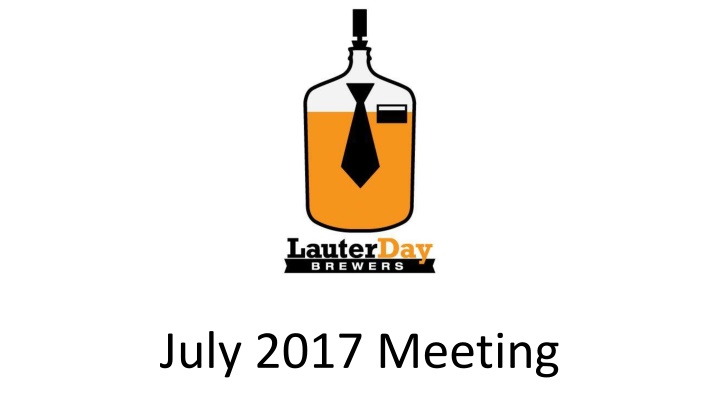

![Download Book [PDF] From This Moment: Special Edition Paperback (After We Fall](/thumb/42280/download-book-pdf-from-this-moment-special-edition-paperback-after-we-fall.jpg)
![READ [PDF] Fallen King (Moon Lake Protectors)](/thumb/42281/read-pdf-fallen-king-moon-lake-protectors.jpg)



